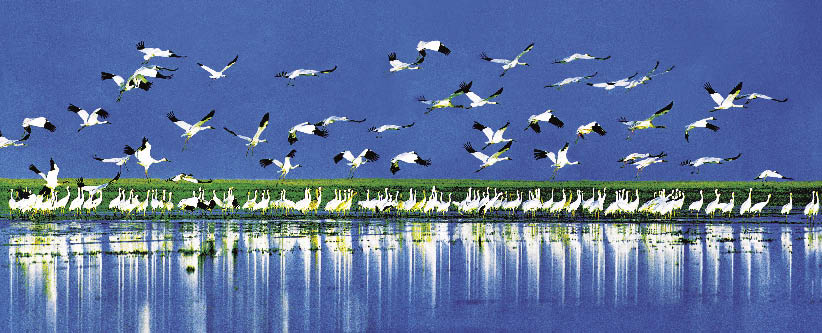By HAN LI
The Green Drive of Eco-Jiangxi
The Green Drive of Eco-Jiangxi

IN the context of regional integration, the term “rapid take-off” is aptly applied to describe a very fast process speed. In 2006, as part of the central government’s regional integration strategy, six provinces in Central China – Shanxi, Anhui, Jiangxi, Henan, Hubei and Hunan – launched a regional joint “rapid take-off” strategy, and created a platform for regional cooperation – the Central China Investment and Trade Expo (Central China Expo).
The fifth such event will take place in Jiangxi’s provincial capital Nanchang from September 26 to 28. While the Jiangxi government was preparing for the event, I visited the province to check the pulse and the green awareness of this land, famous for its “red” credentials.
“Triple Culture”
Jiangxi lies to the south of the Yangtze River in its middle and lower reaches. It is the common hinterland of three economic zones: the Yangtze River Delta, the Pearl River Delta, and the West Bank of the Taiwan Strait. Famous for its long history and splendid culture, the beautiful landscape and the outstanding people also deserve praise.
Jiangxi is the home of green culture. Here every inch of land is rich in wonderful treasures. The sky is blue, the water clear, the mountains green, and the scenery beautiful. To be here is to be walking through a landscape painting, among the Jinggang, Sanqing, and Mingyue mountains, by the Ganjiang and Yangtze rivers and the Poyang Lake.
Here, the “cradle of red culture,” every mountain records the splendid history of the Chinese revolution. The capital is the site of the Nanchang Uprising of 1927, where the first shots were fired in the people’s revolution. Ruijin, known as the “Red Capital,” records the arduous years of fighting by Mao Zedong and other revolutionaries in southern Jiangxi and western Fujian to establish revolutionary base areas. The Jinggangshan Revolutionary Memorial Site and Qiushou Uprising Pingxiang Memorial Hall trace the Jiangxi people’s historic footprints along the revolutionary road.
Jiangxi is an important birthplace of ancient civilization, the beneficiary of thousands of years of ceramic, religious, and theater cultures. The praise of the great Tang poet Wang Bo (650-676), “blessed with a favorable climate, fertile land, rich resources and outstanding talents,” and Fuzhou’s accolade, “home of talents,” testify to Jiangxi’s special allure.
Red, green and antiquity constitute the triple aspects of Jiangxi, precious assets that tempt visitors to linger longer and enjoy its charms.
“Rapid Green Take-Off”
Driving along highways to Nanchang’s neighboring cities, you encounter roadside billboards exhorting “scientific development, performance transcendence and eco-friendly advancement.” This slogan speaks of a new development concept that the province has adhered to while striving for economic and social progress.
In recent years, Jiangxi has concentrated on joining the globalized world by exploiting its proximity to the Yangtze, Pearl and Minjiang deltas and its links with Hong Kong, Macao and Taiwan. As a result of its strenuous efforts in introducing large projects, Jiangxi has become a hot area for investment in Central China, and tides of investors have converged on the province. In 2009, despite natural disasters and the global financial crisis, Jiangxi’s economy grew by 13.1 percent, its GDP amounting to RMB 758.92 billion (US $1 = RMB 6.77). It also optimized its economic structure and realized coordinated economic development.
But the people of Jiangxi are not carried away by this promising economic performance. They are guided by other principles: “The environment should not be sacrificed for economic development” and “the eco-environment is as important as wealth development.” Against the background of the central government’s “industrial gradient transfer” strategy promoting the shifting of industry from the eastern and coastal region to central and western China, Jiangxi has accelerated construction of a low-carbon ecological industrial system, and adhered to developing a green economy. At the end of 2009, the State Council made the construction of the Poyang Lake Eco-economic Zone a national strategy, aiming to build the Poyang Lake area into a national demonstration zone for China’s great lake areas, a water ecology conservation zone in the middle and lower reaches of the Yangtze, a lead area for accelerating the “green take-off” of Central China, and an important platform of international cooperation in eco-economy. In addition, the province will be a key regional production base of fine-quality agricultural products, an eco-tourism base, and an industrial base of solar power, new energy sources, bio-industry and aviation. It will also upgrade its copper, iron and steel, chemical, automobile and other traditional operations, to open a new road of coordinated development in both ecology and economy.
Some economists are of the view that this may make Jiangxi a new economic development pole in China.
Central China Expo Provides the Propulsion
Alongside the Poyang Lake scheme, the hosting of the Fifth Central China Investment and Trade Expo gives Jiangxi new opportunities to display its image, strengthen cooperation and attract investment.
A significant part of the strategy to promote the development of Central China and the six provinces in this region, the Central China Expo is also an important window to present a new image and new achievements. It will help Chinese and foreign businesspeople to understand policies on investment in Central China, obtain information about key projects and conduct economic exchanges.
The theme of the Fifth Central China Expo is “opening-up, cooperation, win-win, take-off.” The main contents include promotion of investment projects, projects with adjacent regions, trade exhibitions, and summit forums. The emphasis will be on attracting investment, regional cooperation, expansion of domestic and foreign trade, and development of a low-carbon economy. It will welcome guests from all quarters with open arms, adding even greater thrust to Jiangxi’s rapid “take-off.”
Services
Economy
- Eco-agriculture and Eco-tourism Power Nanchang’s Green Development
- Balance Environmental Protection and Economic Prosperity – Nanchang Looks to European Technology for Green Development
- Sustainable Growth Requires Wiser Energy Use
- Chinese Economy: On the Path of Scientific Development
- China's Economy over the Last Ten Years

